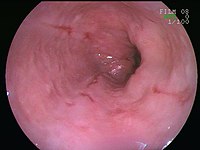
Photo from wikipedia
BACKGROUND Abdominal obesity increases the risk of gastroesophageal reflux disease (GERD). This study aimed to determine the association between GERD and abdominal fat area quantified by computed tomography (CT). METHODS… Click to show full abstract
BACKGROUND Abdominal obesity increases the risk of gastroesophageal reflux disease (GERD). This study aimed to determine the association between GERD and abdominal fat area quantified by computed tomography (CT). METHODS We analyzed the effect of abdominal fat area on gastroesophageal reflux symptoms and erosive esophagitis using logistic regression models in 5,338 participants who underwent abdominal fat measurement CT and screening esophagogastroduodenoscopy. RESULTS Participants with reflux symptoms and erosive esophagitis were diagnosed in 1,168 (21.9%) and 671 (12.5%), respectively. Multivariate analysis showed that subcutaneous and visceral fat areas were significantly associated with reflux symptoms and erosive esophagitis. The adjusted odds ratio (OR) in the fourth quartile of visceral fat area compared with that in the lowest quartile was 1.98 (95% confidence interval (CI) 1.63-2.39) for reflux symptoms and 2.33 (95% CI 1.80-3.01) for erosive esophagitis. Visceral fat area had a stronger effect in the younger age group. In the group <50 years, the adjusted OR in fourth quartile of visceral fat area was 2.70 (95% CI 1.86-3.94) for reflux symptoms and 3.59 (95% CI 2.22-5.80) for erosive esophagitis. High visceral-to-subcutaneous fat ratio (VSR) increased the risk of reflux symptoms and erosive esophagitis in participants with body mass index <25 kg/m2 and normal waist circumference. CONCLUSION Subcutaneous and visceral fat areas were associated with an increased risk of reflux symptoms and erosive esophagitis. High VSR increased the risk of reflux symptoms and erosive esophagitis in participants with normal body weight and waist circumference.
Journal Title: Digestive diseases
Year Published: 2023
Link to full text (if available)
Share on Social Media: Sign Up to like & get
recommendations!